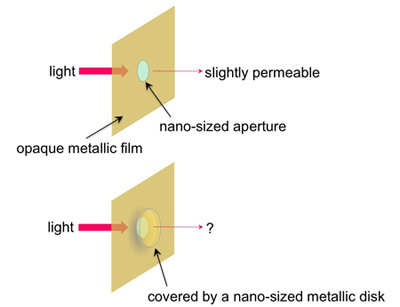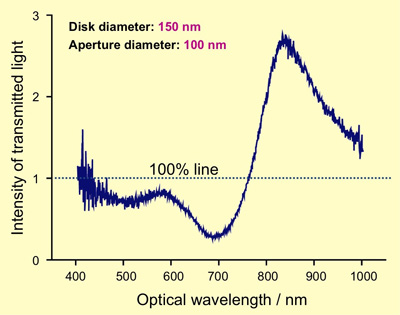
The collaborative research group of Prof. H. Okamoto in IMS, Prof. K. Imura in Waseda Univ., and Profs. K. Ueno and H. Misawa in Hokkaido Univ. found a novel optical phenomenon observable only in nanometer scale systems. They examined light intensity transmitted through a nanometer-scale aperture opened on an opaque metallic screen. When the aperture is obscured by an opaque metallic disk with a larger diameter than the aperture, the transmitted light was found to be, paradoxically, even stronger than that without the disk.
Under conventional macroscopic optics that we experience in daily life, light propagates straight through space. If there is an opaque obstacle on the optical path, the intensity of the propagating light must be greatly reduced (Fig. 1). However, in the present study it has been revealed that this picture no longer holds when the size of the optical system is nanometer regime.
The research group examined intensity of light that transmits through a sub-wavelength aperture opened on an opaque metallic film. When the aperture size is less than the optical wavelength, the most part of the light cannot transmit through the aperture and only limited portion reaches the back-side of the film. What happens when an opaque metallic nanodisk covers the aperture on the back-side of the film? The research group found that the transmission intensity of the light was enhanced compared with the case without the disk, when the nanodisk is placed close enough (ca. 30 nm) to the aperture!
They analyzed the optical transmission characteristics (Fig. 2), and as a result it turned out that this anomalous transmission behavior arise from the peculiar property of optical excitation of metallic nanoparticles, called "localized plasmon resonance". Plasmon resonances have attracted much attention recently for their possible application to optical information processing, ultrasensitive chemical analysis, biological studies, novel chemical reaction fields, and so forth. The present achievement yields fundamental understandings of characteristic behavior of plasmon resonances of metallic nanoparticles, which may be essential in applications mentioned above.
 Fig. 1 Transmission of light through an aperture on an opaque metallic film (top) and that covered by a metallic disk (bottom).
Fig. 1 Transmission of light through an aperture on an opaque metallic film (top) and that covered by a metallic disk (bottom).
 Fig. 2 Spectral transmission characteristic of a nanoaperture (diameter ca. 100 nm) covered with a gold nanodisk (diameter and thickness ca. 150 nm and 35 nm, respectively). Unity of the ordinate scale (100% line) corresponds to the same transmission intensity as that of the aperture only without the disk. From this spectrum, it is clear that the transmission is enhanced by the disk that covers the aperture at wavelengths >770 nm and reduced at <770 nm.
Fig. 2 Spectral transmission characteristic of a nanoaperture (diameter ca. 100 nm) covered with a gold nanodisk (diameter and thickness ca. 150 nm and 35 nm, respectively). Unity of the ordinate scale (100% line) corresponds to the same transmission intensity as that of the aperture only without the disk. From this spectrum, it is clear that the transmission is enhanced by the disk that covers the aperture at wavelengths >770 nm and reduced at <770 nm.
Paper Information
Journal: Nano Lett., 2011, 11 (3)
Title: Anomalous light transmission from plasmonic capped nano-apertures
Authors: Kohei Imura, Kosei Ueno, Hiroaki Misawa, Hiromi Okamoto
Related Information
This paper was picked up in “New Scientis ” (Issued date: 19 February 2011, p.18)
OKAMOTO Group
http://www.ims.ac.jp/english/know_en/photo/okamoto/okamoto_en.html
1108

 Fig. 1 Transmission of light through an aperture on an opaque metallic film (top) and that covered by a metallic disk (bottom).
Fig. 1 Transmission of light through an aperture on an opaque metallic film (top) and that covered by a metallic disk (bottom). Fig. 2 Spectral transmission characteristic of a nanoaperture (diameter ca. 100 nm) covered with a gold nanodisk (diameter and thickness ca. 150 nm and 35 nm, respectively). Unity of the ordinate scale (100% line) corresponds to the same transmission intensity as that of the aperture only without the disk. From this spectrum, it is clear that the transmission is enhanced by the disk that covers the aperture at wavelengths >770 nm and reduced at <770 nm.
Fig. 2 Spectral transmission characteristic of a nanoaperture (diameter ca. 100 nm) covered with a gold nanodisk (diameter and thickness ca. 150 nm and 35 nm, respectively). Unity of the ordinate scale (100% line) corresponds to the same transmission intensity as that of the aperture only without the disk. From this spectrum, it is clear that the transmission is enhanced by the disk that covers the aperture at wavelengths >770 nm and reduced at <770 nm.